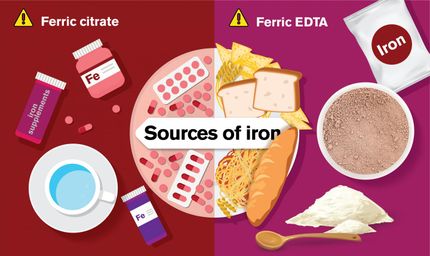When less is really more
Iron supplements may be less effective when given in brief intervalls
Advertisement
Anaemia is often the result of an iron deficiency. In such cases the patients, who are typically female, will be prescribed iron supplements to be taken daily. In cases of severe deficiency, the dosage is increased to several tablets a day.
A new study reveals that it may be difficult for the body to absorb iron in quantities that are necessary and desirable when the supplement doses are administered in 24-hour intervals.
This may be due to a small, protein-like molecule with the name of hepcidin. As soon as iron enters the body, hepcidin production begins in the liver. This tiny protein, which is composed of just 25 amino acid building blocks, then is released into the bloodstream and reaches the intestine, where one of its functions is to regulate the amount of iron absorbed into the body through the cells of the gastrointestinal tract. A group of researchers working with Diego Moretti, senior assistant to ETH Professor Michael B. Zimmermann, has now shown how hepcidin inhibits the absorption of iron supplements in the intestine more profoundly than previously thought.
Hepcidin has an inhibiting effect
In their study, the scientists observed over 50 young women whose iron reserves were depleted but who did not yet suffer from anaemia. The women received a daily dose of at least 40 milligrammes of iron, as is commonly prescribed in cases of iron deficiency. Afterwards, the researchers measured how the hepcidin concentration developed, and quantified its effect on the absorption of subsequent doses of iron. They found that the hepcidin reached its peak concentration after six to eight hours, but even 24 hours after the first dose of iron it was still present in high enough quantities to markedly reduce absorption of the second dose. The body was only partly able to absorb this second dose of iron, which was given either on the same day or 24 hours after the first dose.
Are half measures best?
Traditional iron supplementation is often associated with undesirable side effects such as gastrointestinal complaints. Such issues are closely related to the dosage of iron given, and they are also one of the reasons why many patients stop taking supplements.
If absorption efficiency were to be improved, it would be possible to achieve a greater biological effect from a smaller dose of iron while also reducing side effects. "To improve the percentage of iron absorbed, it would likely be more efficient to wait longer between doses," says Moretti.
However, he does concede that two limitations of the study: the participants in the study were all healthy young women without anemia, and their iron absorption was observed only over a two-day period. The behaviour of the hepcidin concentration over the course of an iron supplementation regimen lasting several weeks will be the subject of a follow-up study, preparations for which are already underway. Here, the scientists are studying iron supplementation over periods lasting two and four weeks.
To analyse iron reabsorption, the researchers used stable iron isotopes as indicator substances. These substances have a modified ratio of stable iron isotopes. Iron-56 is the most frequent naturally occurring stable iron isotope (91.7 percent), followed by iron-54 (5.8 percent) and iron -57 (2.1 percent). Iron-58 occurs only in trace amounts. For their analysis, the scientists used tablets with increased quantities of iron-57, iron-54 and iron-58. The researchers were able to measure endogenous iron absorption by observing isotope ratio changes within the body.
Original publication
Diego Moretti, Jeroen S. Goede, Christophe Zeder, Markus Jiskra, Vaiya Chatzinakou, Harold Tjalsma, Alida Melse-Boonstra, Gary Brittenham, Dorine W. Swinkels, and Michael B. Zimmermann; "Oral iron supplements increase hepcidin and decrease iron absorption from daily or twice-daily doses in iron-depleted young women"; Blood; 2015




























































